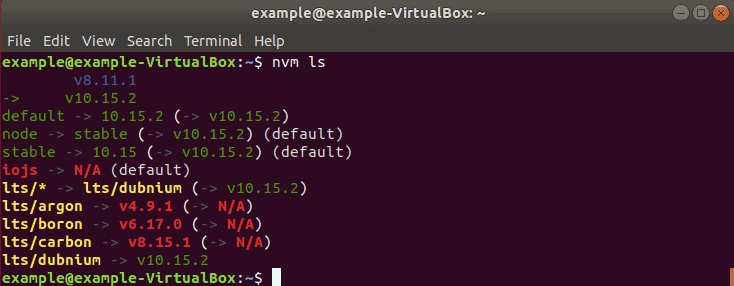
More specifically, providing a partial version can narrow down the available list. Ls-remote lists all available versions, but be prepared for a very long list. We can check the current version with the following command: $ nvm current v15.4.0

nvmrc 15.4.0 $ nvm use Found '/Users/fuje/.nvmrc' with version Now using node v15.4.0 (npm v7.0.15) nvmrc file if no version is supplied on the command line. Afterward, nvm use, nvm install, nvm exec, nvm run, and nvm which will use the version specified in the. nvmrc file can be created for convenience, which takes SemVer format, or node, or default. The default version is the one that carries over to all shells. How can we make a specific node version persistent?

If you start a new shell, the newly set node.js version will be lost. Nvm use sets a specific version for the current shell.
#Node js nvm install
This can be achieved with the following commands: $ nvm use 10.16.0 $ npm install -g following command will get the latest supported npm version on the current node version: $ nvm install-latest-npm You may wonder how v10.16.0 uses a later version of npm than v13.9.0. The arrow in the above output shows that the current version of node.js is 10.14.0. If the specific version has already been installed, it will not be reinstalled: $ nvm install 10.14.0 v10.14.0 is already installed. # 100.0% Computing checksum with shasum -a 256 Checksums matched! Now using node v10.14.0 (npm v6.4.1) The semantic version format is defined by SemVer: $ nvm install 10.14.0 Downloading and installing node v10.14.0. We can also specify the exact version to be installed. This can be verified: $ node -v v15.4.0 $ npm -v 7.0.15 The above output states that npm 7.0.15 is used along with node.js 15.4.0. # 100.0% Computing checksum with shasum -a 256 Checksums matched! Now using node v15.4.0 (npm v7.0.15) "$NVM_DIR/bash_completion" # This loads nvm bash_completionĪfter nvm is installed, we can use the following command to install the latest version of node.js: $ nvm install node Downloading and installing node v15.4.0. In the profile file, such as ~/.bash_profile, we see these lines added: export NVM_DIR="/Users/fuje/.nvm" &. The script, install.sh, clones the nvm repository to ~/.nvm, and attempts to add the source lines from the snippet below to the correct profile file ( ~/.bash_profile, ~/.zshrc, ~/.profile, or ~/.bashrc). Nvm can be installed by curl or wget command: $ curl -o- | bash $ wget -qO- | bash
#Node js nvm windows
nvm works on any POSIX-compliant shell (sh, dash, ksh, zsh, bash), in particular on these platforms: unix, macOS, and windows WSL.

It’s designed to be installed per-user and invoked per-shell. Now install the latest stable version of node.Nvm manages node.js and npm versions. Now check if the nvm is installed by typing: The script clones the nvm repository to ~/.nvm and adds the source line to your profile (~/.bash_profile, ~/.zshrc, ~/.profile, or ~/.bashrc).
#Node js nvm update
To install or update nvm, use the install script using cURL:

#Node js nvm full version
The full version of Raspberry Pi Raspbian comes with node.js pre-installed but if you chose to install the light version than you will need to follow these steps to install node.js. A number of our examples use node.js so you may need to install node before you can run our JavaScript examples. Node Version Manager (NVM) is a tool that allows you to install versions for node.js.


 0 kommentar(er)
0 kommentar(er)
